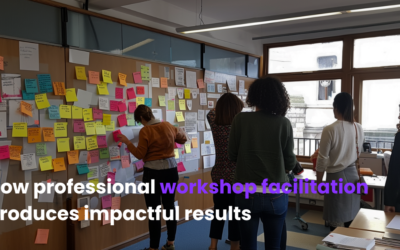How Strategic Prioritisation Transforms Challenges into Impactful Solutions
In our work as facilitators, we often see the same challenges repeat across industries: organisations are filled with talented people and bold ideas, yet struggle to narrow their focus to what will truly drive impact. Strategic prioritisation is the answer, but it’s easier said than done. The process requires navigating through a vast sea of ideas, facing limited resources, and making hard choices. As facilitators, we help teams not only brainstorm effectively but also build consensus around the most impactful choices. We call this a “Problems Worth Solving Workshop” and it is surprisingly powerful.
At the start of each session, we gather the group and set the scene. We ask them to leave daily distractions behind, choosing a setting where they can immerse themselves in the process. Our purpose is clear: we’re here to make tough calls, and that starts with understanding what’s truly possible within the confines of their available resources. The simple act of calling out distractions and taking a moment to reflect on those callings allow us to centre and focus on the task ahead of us.
Our first step in the workshop involves generating ideas. We begin with brainstorming, a process that looks deceptively simple on the surface but is a delicate dance of inclusivity and structure. Each participant takes a moment to think independently before we dive into discussion. This method ensures that everyone, especially the quieter voices, has a chance to contribute without judgement or groupthink. Using Post-it notes, we encourage participants to jot down as many ideas as possible. At this stage, quantity trumps quality; we want every thought out on the table. Watching ideas flow from individuals to collective conversation is always inspiring. Each sticky note represents a piece of potential.
If you are interested in the detailed process of running this workshop, feel free to download our Problems Worth Solving Workshop guide.
Now we ask participants to work with the Four Actions framework—Eliminate, Raise, Reduce, Create. This is where things start to get real. Each person applies their idea to one of the four axes and we can immediately start to see ideas leap to life.
Because everyone has been working independently, there can be some doubling up of ideas. It can be powerful when you see the same idea expressed in different ways. As facilitators it is useful to call out this mismatch – it is a vital first step in gaining alignment and consensus.
Once all the ideas are articulated, we ask participants to group similar ideas together. This adds clarity and allows us to see patterns emerge. You can feel the energy shift in the room as the group starts to realise which ideas have real weight and which might need to wait.
After categorising, it’s time to vote. Voting is essential because it distils ideas further and brings us closer to our priorities. We hand out “voting stars” or similar markers and give everyone three votes to cast however they see fit.
Watching this process unfold, I’ve seen individuals invest all their stars in one concept that they passionately believe will transform the organisation. Others might spread their votes, giving each idea they think valuable a little nudge. In a matter of minutes, we’re left with a new hierarchy of priorities, and the sense of purpose in the room deepens as people start to see their focus take shape.
At this point, we face the toughest step—choosing between ideas with equal promise. To help with this, we introduce the “Even Over” framework. This method involves choosing to focus on one idea “even over” another, forcing the group to clarify its priorities further. I’ll never forget a recent session where a team had to decide to prioritise customer experience “even over” product expansion. Watching them wrestle with this trade-off was powerful. They understood the need to invest in customer loyalty but struggled to let go of the temptation to expand features. By working through “Even Over,” the team left with clarity, prepared to dive deep into customer experience improvements.
Once priorities are set, we don’t just leave things at the conceptual level; it’s time to turn these decisions into actionable strategies. Here’s where we introduce the “How Might We” framework—a simple but transformative tool that can turn even the most abstract ideas into actionable solutions.
We often encourage participants to think in terms of “How might we achieve X for Y audience so that Z change happens?” This clarity of phrasing shifts us from a wish list of ambitions to a practical roadmap.
A recent workshop saw a team reframe their broad goal of “improving customer onboarding” into a “How Might We” statement: “How might we create a seamless onboarding experience that reduces customer drop-off rates by 20%?” This shift brought immediate clarity and helped the team align on specific actions to pursue.
The final piece of the puzzle is resourcing. We don’t leave these prioritised ideas hanging; we help teams outline what they’ll need to make each idea a reality. Using a problem resource canvas (another of our tools), participants identify the resources, stakeholders, and timelines required. This canvas exercise acts as a bridge from abstract strategy to grounded action. As they list out the resources—financial, technical, human—it becomes clear that they have a defined path forward. We guide them to think about how they’ll manage these projects and what workstreams need to happen first.
Strategic prioritisation isn’t about ending with a pretty list of ambitions. Instead, it’s about creating a framework that propels teams toward tangible outcomes. The magic of prioritisation is in its power to direct energy where it matters most, and seeing this process take shape is a rewarding experience every time. The team doesn’t just walk away with new ideas; they leave with a roadmap to make those ideas real. They’re focused, aligned, and ready to drive impact, even within the constraints of their resources.



